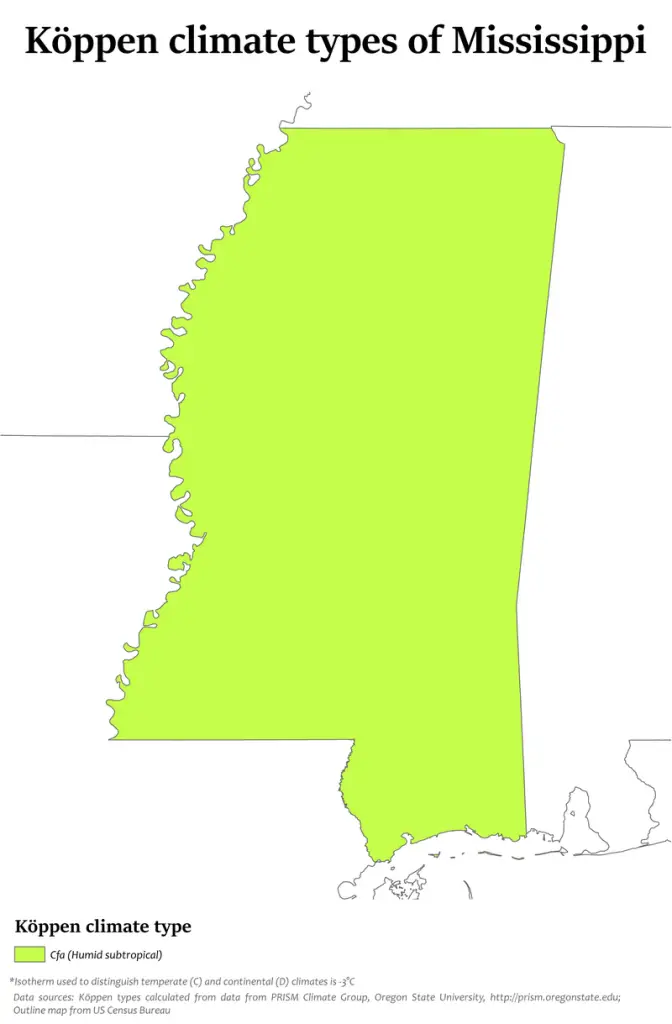Mississippi Plant Hardiness Zones
| USDA Hardiness Zone | Average Minimum Extreme Winter Temperature Range Fahrenheit (°F) Celsius (°C) | Average Last Frost Date Range In Spring (Beginning Of The Growing Season) | Average First Frost Date Range In Autumn (End Of The Growing Season) |
|---|---|---|---|
| 7b | 5°F to 10°F -15°C to -12.2°C | Early April | Late October to Early November |
| 8a | 10°F to 15°F -12.2°C to -9.4°C | Mid to Late March | Early to mid-November |
| 8b | 15°F to 20°F -9.4°C to -6.7°C | Mid to Late March | Early to mid-November |
| 9a | 20°F to 25°F -6.7°C to -3.9°C | Early to mid-March | Mid to Late November |
| 9b | 25°F to 30°F -3.9°C to -1.1°C | Mid to Late February | Early to mid-December |
Mississippi Growing Conditions

Credit to Wikipedia
General Climate
Mississippi’s hardiness zones range from 7b to 9b. Its humid subtropical climate is characterized by short, temperate, and mild winters with long, hot, and humid summers. This creates a long growing season with little to no frost during the winter months.
Proximity to the Gulf of Mexico brings in large southerly winds that cause high humidity and moisture. This causes severe thunderstorms and tornadoes from May to September.
In the winter months, precipitation in the form of snow occasionally occurs in north and central Mississippi.
Microclimates
USDA plant hardiness zones are an important starting point for your garden, but you’ll also need to consider microclimates.
Microclimates are areas where specific conditions create a climate different from the climate they’re situated in.
Buildings, fences, paved areas, or short hills and valleys can create these microclimates.
They can be as small as a space in your backyard or as large as a city.
In other words, learn about your local conditions from local experts to see if your garden falls into a microclimate.
Extreme Weather
Thunderstorms & Tornadoes
Thunderstorms are a common occurrence from May through September in Mississippi. This is especially true in the southern area of the state. Thunderstorms cause heavy rains, high winds, and flooding.
In northern parts of the state, tornados are more common. There are an average of 27 tornados annually. These extreme weather events are more likely to occur at the beginning of the year.
Heavy rain, and high winds can cause stress on the garden. To protect against heavy rain, try adding row cover to the garden. This will give protection to the plants needing extra care.
Pruning of hardwood trees and shrubs can mitigate damage caused by heavy winds. By removing wayward and dead branches you create stronger trees which decreases the chance of branch breakage.
Flooding
Flooding has always been a part of the Mississippi weather network, as the Mississippi and Yazoo rivers run through the state.
Heavy precipitation is common year-round, but seasonal flooding usually occurs from December to June. Levees have been built along the Mississippi River to help mitigate flooding.
Unfortunately, due to clear-cutting of trees for urban development and agriculture, flooding is becoming more common and more dangerous. Without tree roots to absorb excess rain and stabilize the ground, river banks become unstable which leads to erosion and flooding.
Planting trees with deep root systems like Bald Cypress is one way to help protect your home and restore the river banks. These plants are great at absorbing excess water during times of high-risk flooding.
Growing Season
Mississippi has a long growing season with an average of 231 days. Frost-free growing ranges from April to December. Gardeners benefit from multiple succession planting in Mississippi, for example, instead of one crop rotation of tomatoes, you can have two!
However, one of the challenges that comes with a long growing season is extreme heat during the summer months. Shade cloth is a great way to stop the hot sun from scorching plants. It is easily removed and stowed away when the rain comes.
Heat tolerant plants are another option when facing a hot growing season. Annual flowers like Zinnia, Cosmos and Dahlia do very well in hot climates.
Mississippi Gardening Tips

Dealing With High Clay Content
The high clay content in the soil is one of the challenges of growing in Mississippi. Over half of the state has a high base of clay in the soil.
The challenge that comes with high clay content in soil is the lack of drainage. Clay also dries out in heat and turns rock hard. This causes compaction, which restricts the movement of water and air. This has a negative impact on plants as it can cause root rot as well as making plants more susceptible to other diseases.
There are several ways to mitigate high clay content in the garden:
- Compost: adding compost and leaf mulch annually helps to build soil and break down the clay
- Fertilizer: adding a layer of garden lime and organic fertilizer before the compost and mulch is also beneficial
- Roots: another tip is to use plants that have a deep tap root as they help to break up clay
- Plants: choose plants that work with the high clay content of the soil, for example, lupine and comfrey
Comfrey is especially noteworthy as it is a bioaccumulator. This means that plants draw up nutrients deep within the soil and store them in their leaves. Comfrey is special because it holds nitrogen (N), phosphate (P), potassium (K). These are key nutrients that are essential in building healthy soil and plants.
You can “chop and drop” this plant as another layer of mulch, breaking up soil and adding beneficial nutrients to the garden. “Chop and drop” refers to cutting the plant at the base and laying it directly onto the garden.
Planting in Saline & Wet Conditions
Closer to the Gulf of Mexico, many gardeners experience more saline and wet conditions.
Saline conditions have high salt content in the soil. This can be extremely hard on the garden and makes it difficult to grow plants.
There are various ways to deal with high salt content in your soil.
- Cover Crops: plant these during the winter season. Cover crops are high in nitrogen and help balance out the saline soil structure. Good choices are:
- Wheat
- Barley
- Rye
- Compost: annually composting organic matter, leaf mulch and manure also helps to dissipate salt and build healthy soil
- Watering: regular watering of your plants with fresh water and organic fertilizers feeds your plants and dilutes the high salt content
- Native Plants: these plants are already adapted and tolerate salty soil and wet conditions. Some great options are:
- Gulf Coast Yucca
- Swamp Lily
- Marshmallow
Consult With Local Professionals
Consulting with local gardening professionals allows you to benefit from their experience with your area’s conditions, the plants that do well there, and overall best practices.
Mississippi Plant Suggestions

Trees
- Bald Cypress (Taxodium distichum)
- Southern Magnolia (Magnolia grandifolia)
- American Beautyberry (Callicarpa americana)
Shrubs
- Scarlet Buckeye (Aesculus pavia)
- Common Serviceberry (Amelanchier arborea)
- Orange Azalea (Rhododendron austrinum)
Flowers
- Gulf Coast Yucca (Yucca alofolia)
- Swamp lily (Crinum americanum)
- Marsh Mallow (Hibiscus moscheutos)
Vegetables
- Chocolate Tomato (Solanum lycopersicum)
- Habanero Chili Pepper (Capsicum chinense)
- Mouse Melon Cucumber (Melothria scabra)
Herbs
- Lemon Beebalm (Monarda citriodora)
- Spotted Beebalm (Monarda punctata)
- Pitcher Sage (Salvia azurea)
Spices
- Spicebush (Lindera benzoin)
- Holy Basil (Ocimum tenuiflorum)
- Chives (Allium schoenoprasum)
Fruits
- Pecan (Carya illinoinensis)
- Dwarf Huckleberry (Gaylussacia dumosa)
- Southern Crabapple (Malus angustifolia)
Succulents
- Prickly Pear Cacti (Opuntia spp.)
- Purple Emperor Stonecrop (Sedum telephium)
- Woodland Stonecrop (Sedum ternatum)
Disclaimer
Any of the above can change and is not exhaustive.
Treat anything above like a good starter guide. Then use that as a foundation as you consult with local gardeners, professionals, forecasts, guides, and organizations.

